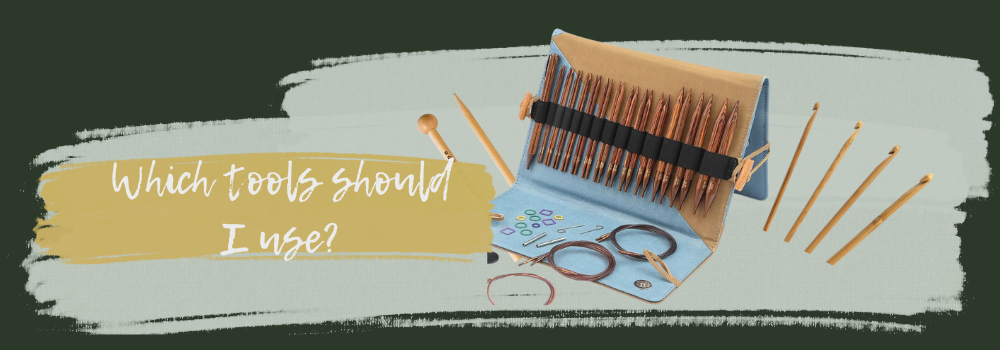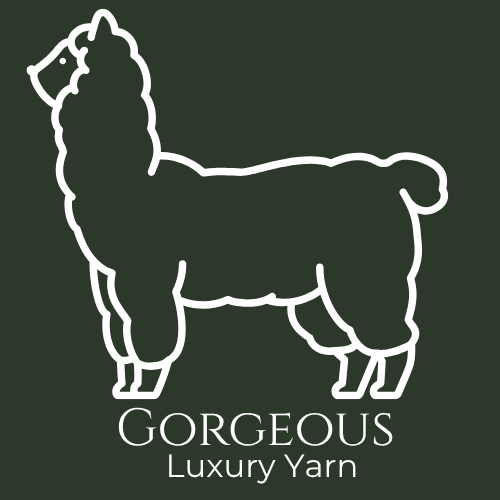
Needles and Hooks - which type, when, and what is best for me personally
Share
Knitting and crochet are timeless crafts that have been passed down through generations, and rely on the perfect combination of yarn and needles. While yarn brings colour and texture to your creations, your choice of hooks and needles plays an equally important role — especially in determining the size, feel, and tension of your stitches.
In this guide, we’ll explore the four key things to consider when choosing your hooks or needles:
- Size
- Shaft
- Tip
- Style (single pointed, double pointed, and circular, and cords
- Tips for using circular needles
1. 📏 Needle and Hook Size
You’ll find needle or hook sizes referenced in millimetres (mm) in the UK and Europe, and numbers in the US. The size refers to the diameter of the hook or needle shaft. Most modern patterns list both mm and US sizes, but it’s a good idea to check. (For example, a US size 8 is 5mm.)
The size you use directly affects your tension — and therefore your finished project. Larger sizes create looser, airier fabrics; smaller sizes produce a denser finish.
We've included a table at the end showing both UK and USA needle/hook sizes.
Now, let's look now at what needles suit you...
2. 🪄The Shaft
There are many types of materials used for shafts — each with their own feel and benefits. To a large extent, it's based on personal preference, so try out different needles if you can before purchasing a full set. However, the different types do have specific purposes, so eventually you may build several sets for different projects and yarn types. The most common types are:
🧶 What I Personally Use Most
I tend to reach for bamboo circulars for almost everything — they’re warm to hold and easy to manage.
3. ✨The Tip
Again, it all depends on the yarn and the project you’re working on.
Tip Type |
Blunter | Sharper |
| Best for | Stranded and thicker yarns. |
Intricate lacework. Tight tension knitters. |
| Pros | Less likely to split the yarn. | Easier to knit into stitches which are tight or multiple. |
| Considerations | If you’re buying your first set, go with a blunter tip — easier to manage and more forgiving. | Metal needles tend to have sharper tips than bamboo or wood. |
Tip for Tips: If you are buying a needle set, you might want to buy just one needle/hook size within the range to start with to see if you get on with the tip.
4. 🛒Style - single pointed needles, double pointed needles, and circular needles
You can find our range here
5. Tips for Using Circular Needles
1. Make sure you choose the right length circular needle for your project.
Circular needles are measured tip to tip. The tips that are 100cm+ are much too long for a small project like a hat or socks, for which you might choose 40cm long circular needles. If you try to use the longer ones on a small project, the knitting will be too stretched and you will constantly be creating secondary loops at different points in the round (just take it from us, you want to avoid that where possible).
- 23-25 cm (9-10 inch) – socks, baby clothes - we recommend double pointed needles for this (see below)
- 40cm (16-inch) - hats, sleeves
- 60cm (24-inch) cord will work for most knitting
- 80cm (32-inch) cord occasionally needed for the largest part of a raglan sweater circumference
- 100cm (39.5-inch) - great for wide flat panel projects, like shawls
2. Circular Shafts
You can get various lengths of shaft for circular needles- choose the smaller ones for small projects like socks or baby garments.
3. Cords
- Nylon-coated steel – no memory
- Plastic - cheaper, and work well, but they will eventually bend to shape
If possible find memory-free + swivel mechanism for smooth no-kink knitting - KnitPro Trendz and KnitPro Ginger

|

|
Other Tools for Circular Knitting
You'll also need some stitch markers, to mark the start of the round, as well as other key points in the project. We include one automatically with all our circular knitting orders. You can buy stitch markers in a wide range of designs and materials - from plastic to silver.
 |
 |

|
Knitting needle and crochet hook size chart
Confused by needle and hook sizing across different countries? This chart will help you convert between UK, US, and metric sizes so you always pick the right tool for your project.
|
Knitting Needles |
Crochet Hooks |
||
|
UK/Europe |
USA |
UK/Europe |
USA |
|
1.50 mm |
000 |
2.25 mm |
B-1 |
|
1.75 mm |
00 |
2.50 mm |
|
|
2 mm |
0 |
2.75 mm |
C-2 |
|
2.25 mm |
1 |
3.125 mm |
D |
|
2.75 mm |
2 |
3.25 mm |
D-3 |
|
3 mm |
3.50 mm |
E-4 |
|
|
3.125 mm |
3 |
3.75 mm |
F-5 |
|
3.25 mm |
3 |
4 mm |
G-6 |
|
3.50 mm |
4 |
4.25 mm |
G |
|
3.75 mm |
5 |
4.50 mm |
7 |
|
4 mm |
6 |
5 mm |
H-8 |
|
4.25 mm |
6 |
5.25 mm |
I |
|
4.50 mm |
7 |
5.50 mm |
I-9 |
|
5 mm |
8 |
5.75 mm |
J |
|
5.25 mm |
9 |
6 mm |
J-10 |
|
5.50 mm |
9 |
6.50 mm |
K-10 ½ |
|
5.75 mm |
10 |
7 mm |
|
|
6 mm |
10 |
8 mm |
L-11 |
|
6.50 mm |
10 ½ |
9 mm |
M/N-13 |
|
7 mm |
10 mm |
N/P-15 |
|
|
8 mm |
11 |
11.50 mm |
P-16 |
|
9 mm |
13 |
12 mm |
|
|
10 mm |
15 |
15 mm |
P/Q |
|
12.50 mm |
17 |
15.75 mm |
Q |
|
12.75 mm |
17 |
16 mm |
Q |
|
15 mm |
19 |
19 mm |
S |
|
19 mm |
35 |
25 mm |
T/U/X |
|
25 mm |
50 |
30 mm |
T/X |
|
35 mm |
70 |
|
|
Happy crafting — and remember, the right tools don’t just help you knit more easily; they make the whole process more joyful. 🧶
If you’ve found this guide helpful, don’t forget to share it with a fellow knitter — or pop over and browse our kits and tools to get started!





